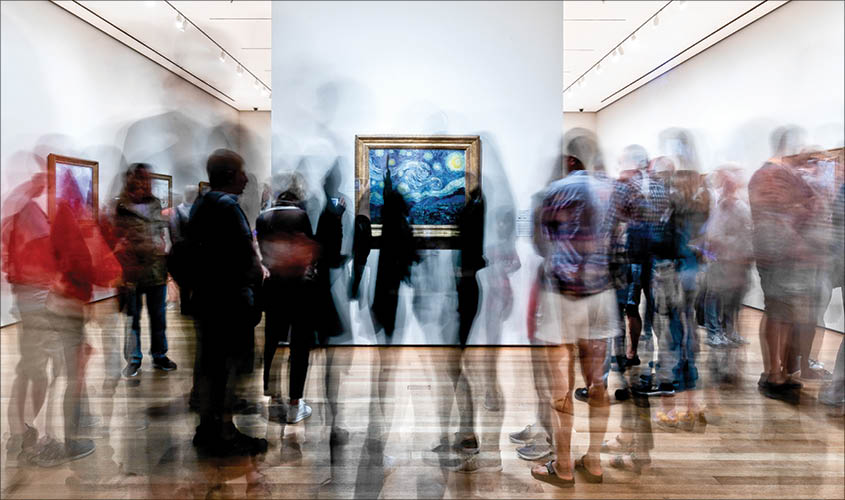The Museum of Modern Art owns only three paintings by Vincent van Gogh, but they include its biggest crowd-pleaser: The Starry Night, which the Dutchman completed in 1889, shortly after having checked into a psychiatric hospital. It has hung in the first gallery on the fifth floor since 2004, when MoMA opened its expansion by the architect Yoshio Taniguchi.
More than anything by Matisse or Picasso, more even than Monet’s late Water Lilies, Starry Night draws the largest throngs in the permanent collection, scrutinising — and photographing — the picture’s flamelike tree and agitated Provençal night sky. (On the museum’s audio guide, Ann Temkin, chief curator of painting and sculpture, notes with a chuckle, “Chances are you aren’t standing in front of this painting alone …”)
I usually skip past Starry Night when I’m at MoMA: too crowded, too familiar. But even art critics need the odd refresher course—so as an adieu to MoMA’s Taniguchi era, I committed to spending half an hour with the museum’s most popular painting. I went at the worst possible time: late Friday afternoon, when the museum offers free admission. It was mobbed.
5:30 p.m. Hear the crowd before I see it. Doors to the fifth-floor collection slide open, and the gallery sounds like Penn Station. With the fourth and sixth floors closed, the crowds in here are bigger than I’ve ever seen—and Starry Night has a semicircle of 50, 60 people in front of it.
5:31 p.m. Station myself in the back of the throng. Back here Starry Night (which measures about 3 feet by 2 1/2) appears a bit larger than postcard scale. Neighbours murmur in French and Turkish. I’m tall enough to see over most heads; the raised smartphones, however, are a killer.
5:33 p.m. Push forward: excuse me, excuse me! Now I can see the brush work properly; the blues of the night sky stutter like Morse code, and the black outline of the church steeple pierces the distant hills. Try to let the picture, so overloaded with clichés of madness and vision, dissolve into pure form. Shoved by woman with GoPro.
5:35 p.m. Affable security guard, stationed to the painting’s left, makes the first of several requests for spectators to stand back. Unlike other bucket-list paintings — at the Louvre in Paris, the Mona Lisa is sequestered behind a wooden banister; at the Uffizi in Florence, Botticelli’s Birth of Venus sits in a recessed niche — Starry Night hangs right on the wall, with no special protection except some nonreflective glass.
5:39 p.m. As I zero in on the crescent moon — ringed by an intense halo; it looks, I realise, more like a Parisian gas light than an astronomical body—a guy with seriously nice arms thrusts his phone in front of my face. He takes a photo, inspects, deletes, takes another, inspects, deletes. I’m looking at him for journalistic purposes only.
5:40 p.m. All right, Jason, look at the painting! Scrutinise the stammering brush strokes in the sky. We call them “churning” or “roiling,” but they aren’t that messy after all; they glide, they ripple, as orderly as the floorboards of The Night Cafe or the stalks of Wheatfield With Crows.
5:42 p.m. I’m in the front now. Try to concentrate on the cypress tree at lower left: the part of the painting literally overshadowed by the starry sky. I’d never really appreciated the brown squiggles that streak through the vegetation — a lovely bit of nonlocal colour in this dusky scene—though I wish I could get closer to see every detail. Elbowed by woman taking photograph of her mother.
5:44 p.m. Easygoing guard springs into action: “No flash!”
5:46 p.m. It’s a little calmer now. Smart teenager to my left tells her friend: “This was my favourite painting when I was, like, 13.” Friend responds with a weary postmodern admission that would make Jean Baudrillard proud: “I know this is the real painting, but it’s like I can’t see it.”
5:49 p.m. Look longingly past Starry Night to The Olive Trees, an equally compelling van Gogh in the same room, with just one person in front of it. Told myself I’d stay put!
5:51 p.m. I have spent as much time looking at visitors’ screens as I have at the van Gogh. It’s not hard to photograph a flat surface in even white light — yet many photos people take here are terrible. The angles are severe, the focus is fuzzy, a third of the canvas is out of frame. These camera-phone shots, I think I understand, don’t aim to be faithful reproductions; they aim to say, “Yes, I was here.” Even with the photographer out of frame, it’s still a selfie.
5:55 p.m. Move to the extreme right side. Only from this angle can I see van Gogh’s impasto; never had I seen the thick, canary-yellow lines in the hollow of the crescent moon.
5:57 p.m. Step to the rear of the crowd. The painting, I have to admit, has not opened up to me after half an hour. But from the rear of the gallery I can see five in-progress photos on smartphone screens, five little Starry Night’s hovering in front of the real thing. And this unbridgeable space between the painting itself and images of it affords a satisfaction of its own. Looking matters, looking is primordial — but looking is not enough to make sense of a masterpiece. What was van Gogh’s project, after all, if not an exploration of the gap between the things in front of your face and the tools you use to represent them?
6 p.m. Timer on my phone vibrates. Pull it out for the first time, and take a selfie.
© 2019 The New York Times

